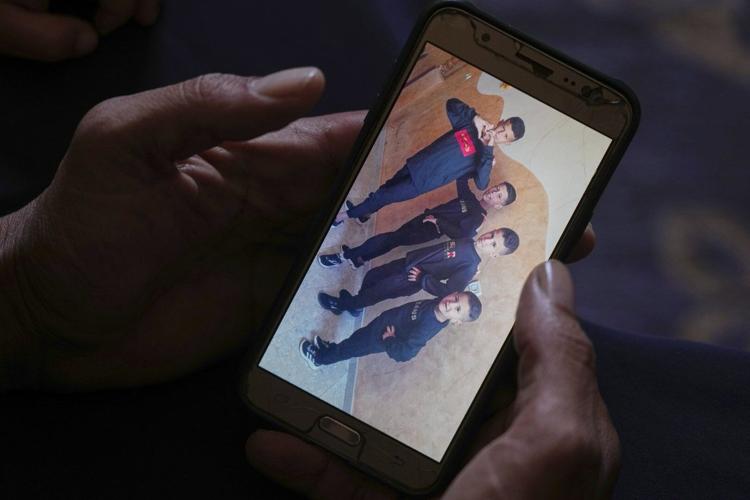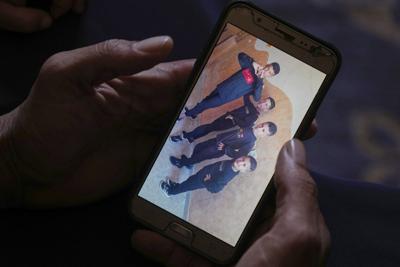DEIR AL-BALAH, Gaza Strip (AP) ÔÇö Three brothers in the Gaza Strip woke up early to run to a local clinic to get ÔÇťsweets,ÔÇŁ their word for the emergency food supplements distributed by aid groups. By the time their father woke up, two of the brothers had been fatally wounded by an Israeli strike and the third had lost an eye.
The strike outside the clinic on Thursday in the central city of Deir al-Balah including 9 children, according to a local hospital, which had initially reported 10 children killed but later said one had died in a separate incident.
The Israeli military said it targeted a militant it said had taken part in the Hamas attack that ignited the 21-month war. Security camera footage appeared to show two young men targeted as they walked past the clinic where several people were squatting outside.
Hatem Al-Nouri’s four-year-old son, Amir, was killed immediately. His eight-year-old son, Omar, was still breathing when he reached the hospital but died shortly thereafter. He said that at first he didn’t recognize his third son, two-year-old Siraj, because his eye had been torn out.
ÔÇťWhat did these children do to deserve this?ÔÇŁ the father said as he broke into tears. ÔÇťThey were dreaming of having a loaf of bread.ÔÇŁ
In a separate development, the Palestinian Health Ministry in said a 23-year-old was beaten to death on Friday by Israeli settlers in the village of Sinjil, near the city of Ramallah. The Palestinian Red Crescent rescue service said another three Palestinians were wounded. The Israeli military said it was looking into the reports.
A ÔÇśsharp and unprecedentedÔÇÖ rise in malnutrition
Hundreds of Palestinians have been killed in Gaza in recent weeks while trying to get food, according to local health officials. Experts say hunger is widespread among the territory’s 2 million Palestinians and that IsraelÔÇÖs blockade and military offensive have put them .
The international aid group Doctors Without Borders said it has recorded a ÔÇťsharp and unprecedented rise” in acute malnutrition at two clinics it operates in Gaza, with more than 700 pregnant and breastfeeding women, and nearly 500 children, receiving outpatient therapeutic food.
ÔÇťOur neonatal intensive care unit is severely overcrowded, with four to five babies sharing a single incubator,” Dr. Joanne Perry, a physician with the group, said in a statement. ÔÇťThis is my third time in Gaza, and IÔÇÖve never seen anything like this. Mothers are asking me for food for their children, pregnant women who are six months along often weigh no more than 40 kilograms (88 pounds).ÔÇŁ
The Israeli military body in charge of civilian affairs in Gaza says it is allowing enough food to enter and blames the U.N. and other aid groups for not promptly distributing it.
Risking their lives for food
and renewed its offensive in March. It eased a 2 1/2 month blockade in May, but the U.N. and aid groups say they are struggling to distribute humanitarian aid because of Israeli military restrictions and a breakdown of law and order that has led to widespread looting.
A separate aid mechanism built around an American group backed by Israel has Palestinians to reach its sites. Witnesses and health officials say hundreds have been killed by Israeli fire while heading toward the distribution points through military zones off limits to independent media.
The military has acknowledged firing warning shots at Palestinians who it says approached its forces in a suspicious manner.
The Israeli- and U.S.-supported Gaza Humanitarian Foundation denies there has been any violence in or around its sites. But two of its contractors told The Associated Press that their colleagues as Palestinians scramble for food, .
The U.N. Human Rights Office said Thursday that it has recorded 798 killings near Gaza aid sites in a little over a month leading up to July 7. Ravina Shamdasani, a spokesperson for the office, said 615 were killed ÔÇťin the vicinity of the GHF sites” and the remainder on convoy routes used by other aid groups.
A GHF spokesperson, speaking on condition of anonymity in line with the group’s policies, rejected the ÔÇťfalse and misleading stats,” saying most of the deaths were linked to shootings near U.N. convoys, which pass by Israeli army positions and have been attacked by armed gangs and unloaded by crowds.
Israel has long accused U.N. bodies of being biased against it.
No ceasefire after two days of Trump-Netanyahu talks
Hamas-led militants killed some 1,200 people in their Oct. 7, 2023, attack on Israel and abducted 251. They still hold 50 hostages, less than half of them believed to be alive, after most of the rest were released in ceasefire agreements or other deals.
Israel’s offensive has killed over 57,000 Palestinians, more than half of them women and children, according to GazaÔÇÖs Health Ministry. The ministry, which is under GazaÔÇÖs Hamas-run government, doesnÔÇÖt differentiate between civilians and combatants in its count. The U.N. and other international organizations see its figures as the most reliable statistics on war casualties.
U.S. President Donald Trump has said he is closing in on another ceasefire agreement that would see more hostages released and potentially wind down the war. But this week after two days of talks with Israeli Prime Minister Benjamin Netanyahu at the White House.
would include a 60-day ceasefire, the release of 10 hostages and the bodies of 18 more, and a flood of aid into the territory. The two sides would also begin negotiations on a lasting ceasefire.
Netanyahu has said he will not end the war without the full disarmament of Hamas, which refuses to lay down its weapons as long as Israel occupies lands the Palestinians want for a future state. Hamas has said it will only release the remaining hostages in exchange for Palestinian prisoners, a lasting ceasefire and an Israeli withdrawal from Gaza.
___
Associated Press writers Bassem Mroue in Beirut, and Julia Frankel in Jerusalem, contributed.
___
Follow APÔÇÖs war coverage at




























